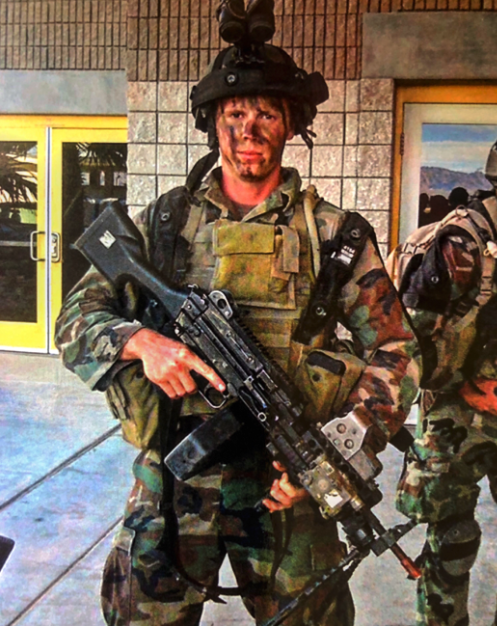Talk with Chadd Wright, a former Navy SEAL, and he will tell you the following.
We are talking about how I manage and have managed in the past stress anxiety and worry in my life. What would you do if I tied your hands behind your back and tied your feet together and dropped you in the deep end of a swimming pool? I’ve lived a pretty stressful life. I’ve done some pretty crazy stuff and I have had to implement and figure out some super important tools in order to be able to stay engaged and in some cases stay alive. I want to give you guys three tools they taught us in a course called pre-buds in order to prepare us to manage the stress that we were about to encounter. When we got to BUDs (Basic Underwater Demolition/SEALs) I have continued to use these three things in my life. probably it’s safe to say on a daily basis to help me get through whatever challenges I’m being faced with in the day. Three really simple things I thought they were freaking corny at first until we started doing things like drown proofing and 50 meter underwater swim and all the crazy evolutions that we did in BUDs and these three things actually are what allowed me to get through them and stay calm and actually perform the way I needed to perform.

The first one is POSITIVE SELF-TALK. So we actually went to a classroom every day in pre-BUDs and we practiced these things we learned. What positive self-talk means is that we are aware of the conversation that’s going on in our head especially during moments of chaos especially during moments that are stressful especially during doing things that are causing anxiety we have to be constantly aware of that conversation that’s going on in our head. We have to control that conversation the first part of controlling it is being aware of it. When we see or recognize our thoughts starting to drift to a place where they don’t need to be, going in the midst of this chaotic situation, we got to reel that back in right the way. I personally reel that back in by counter punching it with a positive affirmation or positive spoken word. All right I’m going to tell myself the truth about the situation and whether that saying something like, I’m experiencing stress or my self-talk starts to tell me that maybe I’m not good enough to do this or maybe I’m not capable of doing this. I will simply tell myself, no man you are trained you are prepared you are capable. It just redirects that self-talk in my head. I think another big way to manage our self-talk is to get ahead of it by being hyper aware of the input and what we are allowing to come into our minds each and every day. I challenge you guys to do what I do almost on a daily basis and that is to audit what I am listening to and who I’m listening to and what forms of media I’m watching to make sure that those things are sources that are going to promote good self-talk that are going to promote the right conversations in my head when I’m experiencing a stressful situation.
The second tool that we learned in pre-BUDs that really helped me especially again when we started doing highly stressful activities and evolutions was VISUALIZATION. Like all these tools I thought it was really freaking corny at first and I was like how is this actually going to work? When I realized visualization really did work was during our 50 meter underwater swim. That evolution was causing me a lot of stress and anxiety especially when I was sitting there on the pool deck waiting for my turn to go and do this 50 meter underwater swim and they were pulling my classmates out of the water and reviving them right there on the pool deck because they were essentially drowning themselves. So I sat there on the pool deck I worked through this visualization process. The way I did it is I closed my eyes and I pictured in my head the perfect outcome on this evolution. I pictured myself completing this 50 meter underwater swim without drowning and I pictured it in very great detail. I tried to incorporate as much into visualization as I possibly could so for the 50 meter underwater swim I’m literally trying to feel the water as it flows across the surface of my skin I’m feeling and actually engaging the muscles in my lats and cupping my hands as I pull through the water effectively and efficiently. I actually thought about and could feel myself getting a little short on air and what that’s going to feel like and how I can control the anxiety. That’s creating and I visualized this process on the pool deck and when I got in and did my 50 meter underwater swim perfectly. I didn’t think I was going to be able to do it so I gained a lot of confidence in the power of this visualization technique right there that day and I’ve continued to use it throughout the rest of my life. The key is to practice it and to incorporate as much detail as you possibly can. If you don’t quite know what the challenge is going to look like just visualize what you want it to look like so you should visualize your perfect scenario and as far as your performance in whatever the challenge is that you’re facing.
The last one that we are going to talk about is a BREATHING TECHNIQUE. Your breath essentially helps you stay present. Your breath is a tremendous tool that you can use to bring you back and be present it also helps you physiologically. In pre-BUDs we learned a breathing technique called 4x4x4 breathing. It’s a four count in breath, a four count hold, and a four count exhale. Four count hold you do that for about four or five rounds it forces you to focus on your breath again which brings you back to present. Your breath forces you to focus on something other than what’s about to happen or the challenge you’re about to face. Another thing it’s going to do it’s going to slow your heart rate down it’s going to relax you so physiologically there are some benefits of getting control of your breath too. It’s going to allow you to recover and ultimately all those things combined it’s going to keep you from panicking. If we let that worry anxiety and stress overcome us that’s what it leads to is panic.
These are the three major techniques that I use that I learned in SEAL training that I use to make it through my career in the SEAL teams and that I use now today to mitigate stress anxiety and worry especially in the midst of a challenging or a chaotic situation.



